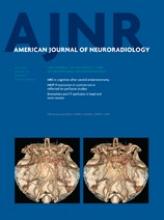Abstract
BACKGROUND AND PURPOSE: Alleviation of aneurysm induced mass effect has been difficult with both conventional endovascular and surgical techniques. Our aim was to study the efficacy of endovascular flow modification on aneurysm-induced mass effect and compression syndrome, as demonstrated by cross-sectional imaging studies and clinical follow-up.
MATERIALS AND METHODS: Thirty aneurysms larger than 10 mm were treated by flow diversion alone and previously had undergone pre- and posttreatment cross-sectional imaging. Pretreatment MR imaging or contrast CT, follow-up angiography at 6 months, and follow-up MR imaging studies between 6 and 18 months were retrospectively analyzed. The neurologic and neuro-ophthalmologic statuses of all patients were recorded before treatment and at the time of follow-up cross-sectional imaging.
RESULTS: At 6 months, 28 aneurysms were completely occluded, 1 had a neck remnant, and 1 had residual filling on angiography. Between 6 and 18 months, 3 aneurysms decreased in size and 27 completely collapsed as demonstrated on MR imaging. Before treatment, 6 patients had vision loss, 10 had double vision due to a third or sixth nerve palsy or both, and 1 had hemiparesis due to brain stem compression. On MR imaging follow-up, vision loss had either improved or resolved in all except 1 patient, double vision had resolved completely (7/10) or partially (3/10), and the patient with brain stem compression became asymptomatic. There was no bleeding observed in this series. One parent artery thrombosis resulted in a major infarct.
CONCLUSIONS: Endovascular flow diversion is a highly effective technique for resolving radiologic mass effect and clinical compression syndromes.
ABBREVIATIONS:
- FD
- flow diverter
- GP IIb/IIIa
- glycoprotein IIb/IIIa
- PED
- Pipeline Embolization Device
- PUFS
- Pipeline for Uncoilable or Failed Aneurysms
- © 2013 by American Journal of Neuroradiology
Indicates open access to non-subscribers at www.ajnr.org












